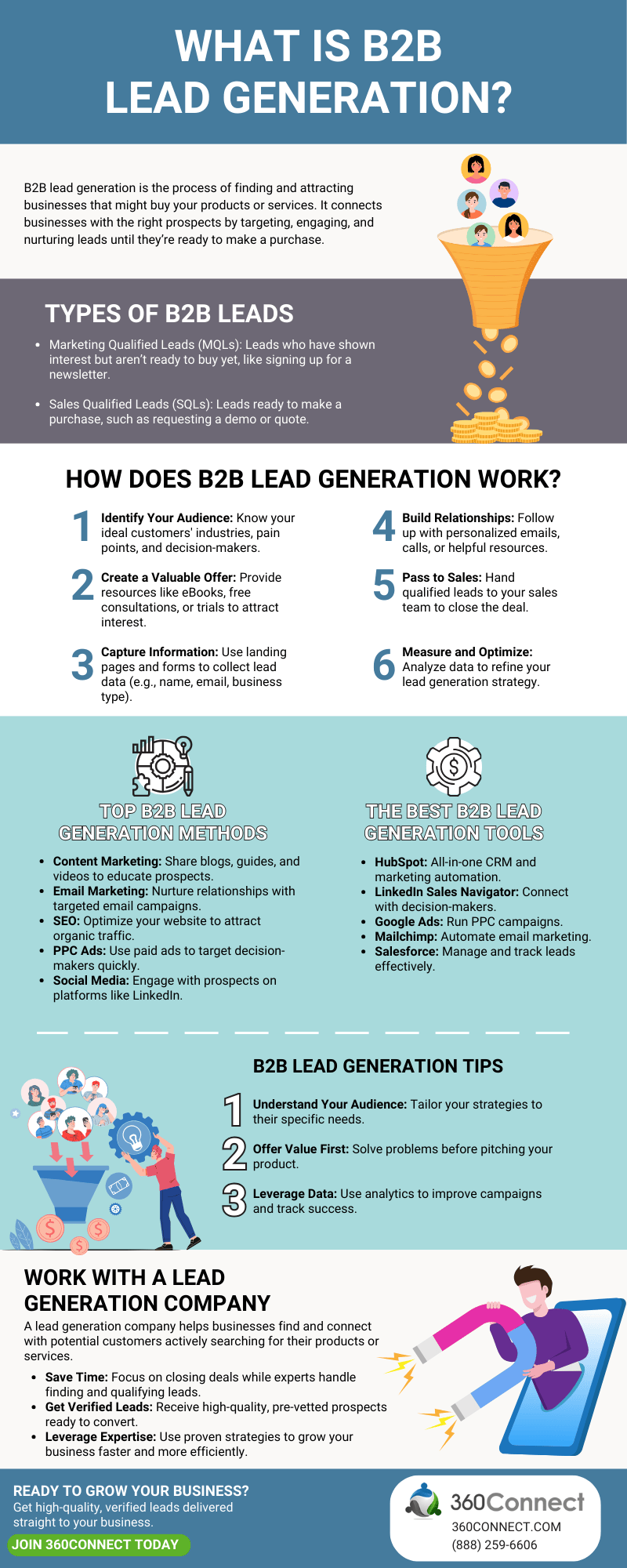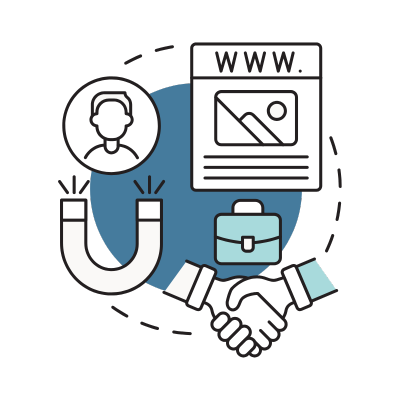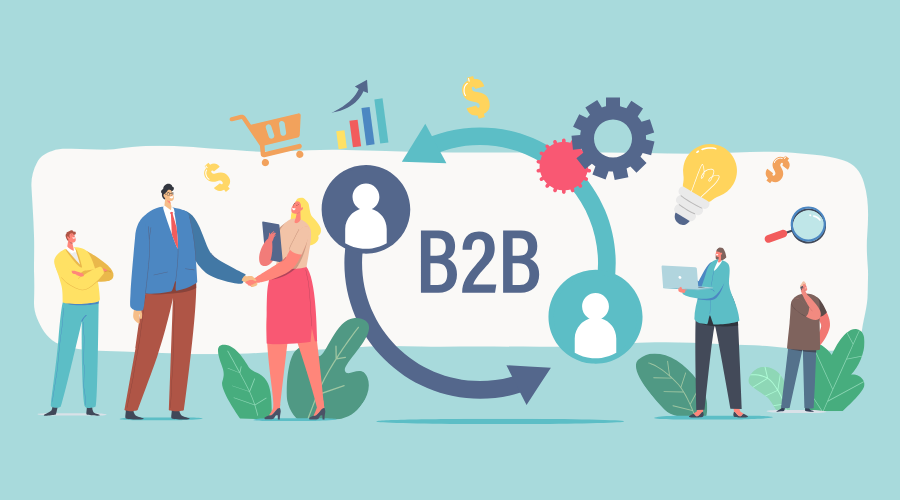You’ve likely heard the term “B2B Lead Generation”…but what exactly does it mean? What is B2B Lead Generation? Well, that’s a good question. Many common misunderstandings regarding B2B Lead Generation are what it means, how it works, the process, and what tools are involved. Which fair enough how are you supposed to know all of that just from the term itself?!
So, if you’re wondering what B2B Lead Generation is or how it could benefit your business, we’ve created an easy-to-follow guide to give you the information you need to fully understand B2B Lead Generation and why it matters for your business success.
What is B2B Lead Generation?
Essentially, B2B lead generation is about connecting with businesses that might want to buy your products or services. It’s the process of finding potential customers—other businesses—and nurturing them until they’re ready to make a purchase.
You may be wondering, “what’s so special about that? Isn’t that just the fundamentals of doing business?” Well, yes and no. While every business needs customers, B2B lead generation is a more strategic and targeted approach to identifying and engaging the right buyers at the right time.
Think about it this way: in traditional business, you might rely on word-of-mouth or general advertising to get new clients. But with B2B lead generation, you’re using focused tools and methods to actively find and connect with decision-makers. It’s not about waiting for buyers to come to you—it’s about seeking them out and building a relationship that leads to a sale.
The real magic of B2B lead generation lies in the ability to fine-tune your efforts. You’re not just casting a wide net and hoping for the best. Instead, you’re crafting strategies to reach businesses that need exactly what you’re offering. The result? More efficient use of your time, better sales opportunities, and stronger business growth.
Related: How to Generate Leads for B2B Sales

Why Does B2B Lead Generation Matter?
We ended the last section by talking about how B2B lead generation allows you to fine-tune your efforts and connect with businesses that need exactly what you’re offering. But let’s dig a little deeper: why does this process matter so much?
Efficiency
Traditional methods of finding customers—like cold calling or relying on referrals—can be hit-or-miss. B2B lead generation takes the guesswork out of the equation by helping you target businesses already interested in what you offer. Furthermore, this means you spend less time chasing dead ends and more time nurturing relationships with potential buyers who are likely to convert.
Strengthens Sales Pipeline
A steady stream of qualified leads keeps your sales team busy and your revenue growing. Without a robust lead generation process, your pipeline can dry up, leading to stalled growth and missed opportunities.
Competitive Edge
In today’s market, businesses are bombarded with options. B2B lead generation helps you stand out by making sure your message reaches the right people at the right time. The result? You’re top of mind when they’re ready to make a purchase.
At its core, B2B lead generation isn’t just about finding buyers—it’s about finding the right buyers and building meaningful connections that drive long-term business success. When done well, it can completely transform how you grow and scale your business.

Types of B2B Leads
Now that we’ve covered what B2B lead generation is and why it matters, let’s talk about the types of leads out there. Not all leads are created equal, and understanding the different types can make a big difference in how you approach them.
In B2B lead generation, leads are typically divided into two main categories: Marketing Qualified Leads (MQLs) and Sales Qualified Leads (SQLs). Let’s break it down.
Marketing Qualified Leads (MQLs)
MQLs are leads who’ve shown some interest in your business but aren’t ready to buy—yet. Think of them as being in the “getting-to-know-you” phase. They may have visited your website, signed up for your newsletter, or downloaded an eBook you offered.
The key to MQLs is nurturing them over time. You’re not trying to sell to them immediately; instead, you’re building trust and keeping your business top of mind. When they’re ready to make a purchase, you’ll already have a foot in the door.
Sales Qualified Leads (SQLs)
SQLs, on the other hand, are ready to take the next step. These leads have shown a clear intention to buy by doing things like requesting a quote, scheduling a demo, or directly contacting your sales team.
With SQLs, the goal is to strike while the iron is hot. They’ve already done their research and are actively considering your product or service. At this stage, it’s all about addressing their specific needs and closing the deal.
So, why do these two types of leads matter for B2B lead generation? Because understanding where a lead stands in the buying journey helps you tailor your approach. By focusing on MQLs and SQLs differently, you’ll save time, improve your conversion rates, and build stronger relationships with potential customers. It’s all about working smarter, not harder!
Related: The High Cost of “Cheap” Leads

Marketing vs. Sales Lead Generation
When it comes to B2B lead generation, you’ll often hear about marketing lead generation and sales lead generation—two approaches that work hand in hand but serve different purposes. Understanding the difference is key to building a strong, balanced strategy.
What is Marketing Lead Generation?
Marketing lead generation is all about attracting leads through awareness and education. It’s typically the first step in the lead generation process and focuses on providing value upfront to engage your audience.
Here’s what marketing lead generation often looks like:
- Content Marketing: Creating blogs, guides, videos, or webinars that address your audience’s pain points.
- Social Media Marketing: Posting on platforms like LinkedIn to reach decision-makers.
- SEO: Optimizing your website so businesses can find you when searching for solutions.
- Email Campaigns: Sending targeted emails to nurture potential leads over time.
The goal? To turn visitors or casual observers into Marketing Qualified Leads (MQLs) who are aware of your business and interested enough to take the next step.
What is Sales Lead Generation?
Sales lead generation takes things further by directly engaging with leads who are closer to making a purchase. While marketing creates awareness, sales lead generation is more about action—it’s when you roll up your sleeves and start building relationships one-on-one.
Sales lead generation might include:
- Cold Calling: Reaching out to decision-makers directly to introduce your product or service.
- Personalized Emails: Sending tailored messages to address specific business needs.
- Networking: Attending industry events or trade shows to connect with potential buyers.
- Follow-Ups: Engaging with leads from marketing campaigns who show interest in moving forward.
At this stage, the goal is to turn Marketing Qualified Leads (MQLs) into Sales Qualified Leads (SQLs) and eventually close the deal.
How Do They Work Together?
While marketing and sales lead generation have distinct roles, they’re most powerful when used together. Marketing builds awareness and trust, ensuring your business stays top of mind. Sales takes the lead when prospects are ready for deeper conversations.
By combining efforts, you create a seamless experience that moves leads through the buying journey naturally. How exactly does it work? We’ll explore this step-by-step in the next section.

How Does B2B Lead Generation Work?
B2B lead generation may sound like a big, complicated process, but it’s actually pretty straightforward when you break it down. At its core, it’s about finding businesses that need your product or service, engaging them, and nurturing them into customers. Here’s a step-by-step look at how it works:
Step 1: Know Your Audience
Before anything else, you need to figure out who you’re targeting. What industries do they work in? What problems are they trying to solve? And what decision-makers should you be talking to? A clear picture of your ideal customer sets the foundation for everything else.
- Research industries that align with your product or service.
- Create a customer persona (e.g., job titles, company size, pain points).
- Use tools like LinkedIn or industry directories to find decision-makers.
Step 2: Create Something They Want
Once you know your audience, the next step is to grab their attention. This could be through a valuable resource like a guide, a free consultation, or even a discount offer. The key is to make it something they find genuinely helpful.
- Develop content like eBooks, whitepapers, or how-to guides.
- Offer free consultations, demos, or trials of your product.
- Highlight how your offer solves a specific problem or adds value.
Step 3: Get Their Information
Now that you’ve caught their interest, it’s time to collect their details. Usually, this happens through a landing page or form where they can provide their name, email, and company info in exchange for your offer. This is how you officially turn them into a lead.
- Create a landing page with a simple, engaging headline.
- Add a lead capture form asking for essential information (name, email, business type).
- Use clear CTAs like “Get Your Free Guide” or “Request a Demo.”
Step 4: Build the Relationship
After collecting their information, don’t let the connection go cold! Follow up with personalized emails, helpful resources, or even a phone call. The goal here is to show them how your product or service can solve their problems.
- Send follow-up emails with helpful content, case studies, or testimonials.
- Personalize communications based on their industry or specific pain points.
- Use automation tools to stay consistent without overwhelming leads.
Step 5: Pass the Lead to Sales
When the lead shows clear signs of being ready to buy (like asking for a quote or a demo), it’s time to hand them off to your sales team. At this stage, they’re looking for more detailed answers, and your sales team is there to seal the deal.
- Schedule a discovery call to dive into their needs.
- Provide your sales team with all the lead’s engagement data.
- Follow up promptly—leads are hottest when their interest is fresh.
Step 6: Measure and Optimize
Finally, don’t forget to measure how well your lead generation efforts are working. Use data and analytics to track which methods bring in the best leads, and refine your strategy from there.
- Track conversion rates from each stage of the process.
- Identify which offers and channels (email, social, PPC) perform best.
- Use insights to tweak your messaging, targeting, and offers.
Overall, the beauty of lead generation is that it creates a repeatable, scalable process for finding new customers. By following these steps, you’re not just generating leads—you’re setting your business up for long-term success.

Top B2B Lead Generation Strategies
So, we provided how it works and some tips, but what strategies are typically used to carry out B2B lead generation? We touched on a few in the “How Does B2B Lead Generation Work?” section, but let’s go over the top strategies in more detail. Each method has its strengths and works best when tailored to your specific audience and business goals.
Content Marketing
Content marketing is all about creating valuable resources that answer your audience’s questions or solve their problems. The idea is simple: if you provide helpful content, your audience will trust you and view your business as a go-to resource.
What to do:
- Write blogs or create guides that address common challenges in your industry.
- Share case studies and success stories to build credibility.
- Develop videos, webinars, or infographics to engage leads in different formats.
According to 76% of B2B marketers, content marketing helps generate leads and demand.
Email Marketing
Email marketing remains one of the most effective ways to nurture leads. It’s direct, personal, and lets you stay in touch with your prospects over time.
What to do:
- Build an email list using lead capture forms on your website.
- Segment your audience to send personalized, relevant content.
- Create drip campaigns to guide leads through their buyer journey.
In B2B marketing, email is considered to be one of the most important channels with 83% of marketers choosing it.
Search Engine Optimization (SEO)
SEO ensures that when businesses are searching for solutions online, they find you. It’s all about optimizing your website to rank higher in search results for keywords your audience uses.
What to do:
- Research keywords your ideal customers are searching for.
- Optimize your website pages, blog posts, and landing pages with those keywords.
- Build backlinks and improve site speed to boost your rankings.
Virtual events (45%) and websites and SEO (45%) are the most powerful marketing channels for generating leads.
Pay-Per-Click (PPC) Advertising
PPC advertising helps you reach your target audience quickly by placing your ads at the top of search engines or social media platforms.
What to do:
- Run Google Ads targeting specific industries or job titles.
- Use LinkedIn Ads to connect with decision-makers in your field.
- Set a budget and test different ad copy to see what works best.
Social Media Marketing
Social media isn’t just for B2C companies—it’s a powerful tool for B2B lead generation, too. Platforms like LinkedIn, in particular, are ideal for connecting with decision-makers.
What to do:
- Share educational content, success stories, and updates about your business.
- Engage with potential leads by commenting on posts or joining industry groups.
- Use targeted ads to promote your offers directly to your ideal audience.
Referrals and Networking
Sometimes, the best leads come from word-of-mouth recommendations or in-person connections. Networking allows you to meet potential clients face-to-face and build trust.
What to do:
- Attend trade shows, conferences, or industry meetups.
- Build relationships with current clients and ask for referrals.
- Offer incentives for referrals to encourage word-of-mouth marketing.

The Best B2B Lead Generation Tools
Need help streamlining your lead generation process? The right tools can make all the difference. Here are five must-have tools to take your B2B lead generation efforts to the next level:
1. HubSpot
HubSpot is an all-in-one CRM and marketing platform designed to manage your entire lead-generation process.
- Use HubSpot’s lead capture tools to collect and organize lead information.
- Automate email campaigns and follow-ups to nurture prospects effortlessly.
- Analyze data with built-in reporting tools to track what’s working.
2. LinkedIn Sales Navigator
For B2B businesses, LinkedIn Sales Navigator is a game-changer when it comes to connecting with decision-makers.
- Search for leads by industry, job title, or location.
- Use InMail to send direct messages to potential buyers.
- Save leads and track engagement to stay organized.
3. Google Ads
Google Ads is essential for running PPC campaigns and driving targeted traffic to your website.
- Bid on keywords that your ideal customers are searching for.
- Create ad campaigns tailored to specific industries or buyer needs.
- Track conversions to see which ads generate the most leads.
4. Mailchimp
Mailchimp is a user-friendly email marketing tool that helps you nurture leads over time.
- Create automated email sequences for consistent follow-ups.
- Use segmentation to personalize messages for different audiences.
- Track open and click-through rates to refine your strategy.
5. Salesforce
Salesforce is a powerful CRM for managing leads and sales data.
- Organize and track leads from the moment they enter your pipeline.
- Integrate with other tools like email and ad platforms for a seamless workflow.
- Use detailed analytics to measure and improve your sales performance.

B2B Lead Generation Tips
You now have a better understanding of B2B lead generation, you know the top methods and tools and you’re ready to get started. Well, slow your roll. We’d like to provide you with some tips to keep in mind that can help improve your lead generation results. Here are three practical tips to consider:
1. Know Your Audience
The better you understand your audience, the easier it is to attract them.
- Research their challenges, goals, and needs.
- Create messaging that speaks directly to their pain points.
2. Offer Value First
Lead generation is about helping, not selling (at least at first).
- Provide resources like guides, webinars, or consultations.
- Focus on solving problems rather than immediately pitching your product.
3. Use Data to Improve
Data is your secret weapon for optimizing lead generation.
- Track which campaigns and tools are delivering the best results.
- Adjust your strategy based on what works.
Final Thoughts: What is B2B Lead Generation?
By now, you’ve got a solid understanding of what B2B lead generation is, why it’s important, and the tools and strategies that can make it successful. Whether it’s through content marketing, email campaigns, or social media outreach, the goal is always the same: connecting with the right businesses at the right time to build meaningful relationships.
But let’s be real—while these strategies are powerful, implementing them effectively can take a lot of time, resources, and expertise. That’s why so many businesses turn to lead generation companies to help streamline the process and deliver results faster.
What is a Lead Generation Company?
A lead generation company specializes in finding and connecting you with businesses actively searching for your product or service. They handle the heavy lifting—identifying prospects, qualifying them, and delivering them to you—so you can focus on growing your business.
While you can generate leads in-house, many businesses choose to work with a lead generation company. Why?
- Save Time: Outsourcing allows your team to focus on closing deals rather than finding leads.
- Cut Costs: You don’t need to invest in expensive tools or train your team on new strategies.
- Better Quality: Lead generation companies specialize in delivering leads that are ready to convert.
At 360Connect, we do exactly that. We help suppliers like you connect with verified buyers in need of your products or services. Instead of spending hours hunting for leads, you can focus on closing deals and scaling your business.
Related: Top 7 Signs Your B2B Business Can Benefit From A Lead Generation Company
Get High-Quality Leads Today
Ready to take your lead generation to the next level? At 360Connect, we connect businesses like yours with buyers who are actively looking for what you offer.
Become a 360Connect supplier today and see how easy it is to grow your business with high-quality leads.

